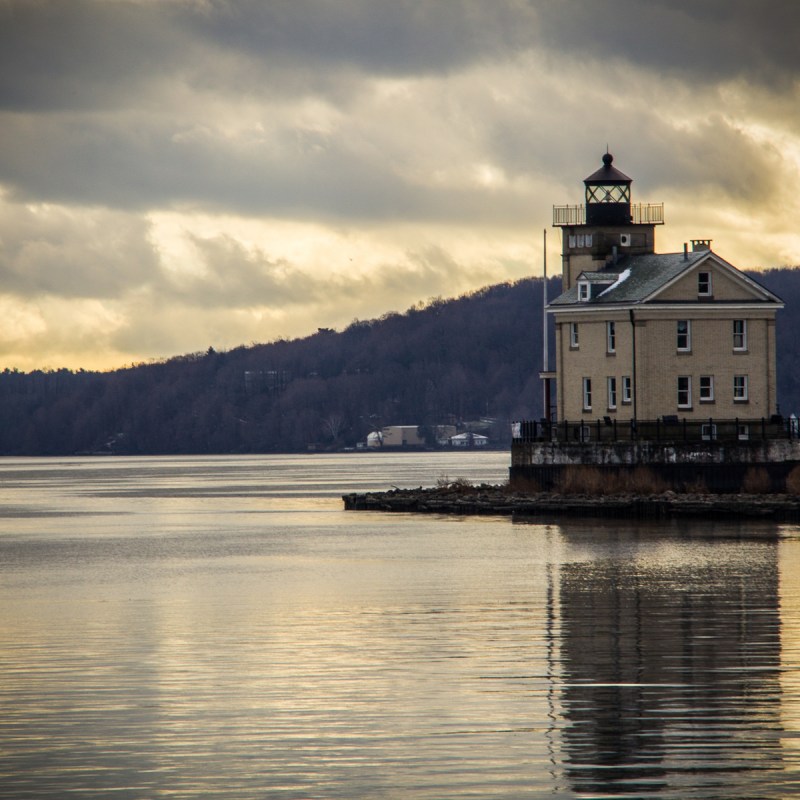
I wasn’t sure about heading to Kingston, New York state’s first capital. After all, my fellow Brits had burned this place down some 250 years ago and I wondered if people here had long memories. Making sure I had left my matches at home, my wife and I headed to Kingston for a summer weekend hoping it was enough time to explore this historic town.
Videos by TravelAwaits
Colonial History In The Uptown Stockade District
We started in one of Kingston’s three historic districts – the Uptown Stockade District. The Stockade District is the site of the original 17th-century Dutch settlement when the town was known as Wiltwyck. Once the Brits arrived, of course, it was all change – name included. Wiltwyck became Kingston (named after the family seat of the Governor’s mother, not, as I had imagined, “Kings Town”). This area still features a number of historic buildings from the 1660s onwards and a unique location, rather unimaginatively called “Four Corners.” There is only one place to start a visit here and that’s the single-story stone building Senate House. New York’s First Constitutional Convention met there and in April 1777, adopted the first New York State Constitution. A month later, the Senate fled as the British advanced. Originally built in the 1670s, the Senate building was burned in 1777 and later restored.

We wandered along the streets with two-hundred-year-old buildings standing shoulder to shoulder with newer structures, some adorned with bright, vibrant murals. Despite this, the historic vibe is palpable and small clues exist (if you look for them) to remind you of days gone by. An older building had bricked-up windows – not a symptom of today’s society but a throwback to the days when taxes were based on the number of windows a building had. On the main street, eclectic stores sit side by side with a long canopy over the sidewalk. They’re very quaint and look like something straight out of the Victorian era, except the canopy was only added in the 1970s! The Stockade district oozes that small-town feeling: cozy, welcoming, and friendly. People even stopped to talk to us as we window shopped. We came across a haberdashery and music store (a true “first”), a barber’s with a classic Vespa scooter in the window (I didn’t ask why), a store dedicated solely to every spice from the Caribbean known to man, and food offerings for every taste.

Best Restaurants In The Uptown Stockade District
We chose to grab lunch at Sissy’s Cafe – clearly a local’s favorite as we had to wait in line for our sandwich and fresh juice before snagging an outdoor dining spot. Simple, fresh, and tasty fare – it hit the mark perfectly. We sat outside and people watched as they considered their own dining options (Greek, deli bar, poke bar, or a small burger joint), stopped to admire the flowering planters, or sat enjoying a good book and a cool shake.
I wish I had seen this place before lunch. Just around the corner from the Senate House and lodged neatly next to the Opera House on Fair Street is The Lunchbox – a small take-out sandwich bar offering soups, salads, and sandwiches and it’s the size of, well, a lunchbox. It is only 30 square feet and contains a fridge, a grill, and a working surface – that’s it. Owner and chef Sean Miller has been there for nine years, and despite pandemics and chilly winters (and perhaps plagues of locusts), is still there. His recipes are not written down and he measures with his palm and fingers. People walking by called out his name – this guy is an institution and every husband’s dream when the wife says she needs a larger kitchen. “We want to make sure that anybody can afford to eat with us,” says Miller. Directly opposite The Lunchbox is Le Canard Enchaine – a swanky French piano bar with its white tablecloths and silver cutlery glinting in the sunlight on the outdoor tables. The contrast could not have been starker.

Historical Attractions In The Uptown Stockade District
A little further along we came to the old Fireman’s Hall – now a museum and every boy’s dream. I tend to have a very limited attention span when I go to museums but I lasted a full 30 minutes here – and saw everything. It’s neat to see ancient fire tenders and appreciate just how much effort was needed to operate a hand-pulled engine in days gone by. Twelve men either side of the engine would pump water. They lasted 5 to 8 minutes before becoming exhausted. It’s interesting, educational, fun — and it’s free.
We headed to Four Corners – an unimaginative name for a unique local attraction. This is apparently the only place in the U.S. where all four buildings on each corner of the intersection are made of stone. I guess you have to grab the limelight however you can. One of those buildings was the “Academy” – the first two-year college in New York. Today, it goes by “Rough Draft” and is a bookstore/coffee house/bar. “Bar” and “books” – is there a better combination of two words in the English language? Grab a drink and a book and sit outside …. and let time slip away.
The district is only eight blocks. Flat and easily walkable but with many interesting distractions along the way, it may take you longer than expected. We visited in June during Pride Month and rainbow flags were everywhere. Even crosswalks had been painted in rainbow colors – how cool is that?

Unwind At Kingston Point Park
That evening I took my wife on a romantic sunset walk on the Tram Trail at Kingston Point Park (aka Rotary Park). This doubles up as a cycle trail too, so take care. There is also a beach and picnic area, and you get a great view of the Kingston (Rondout) lighthouse from the trail too. There is plenty of parking and it’s a flat easy walk along the edge of the Hudson River. We didn’t realize how popular this place gets on a summer’s evening, but it still made for a romantic stroll.

Rondout – Kingston’s Historic Waterfront District
The next morning dawned bright and beautiful – a perfect day to get out on the water and see Kingston from the Hudson. We headed to Rondout – another of the three historic Kingston districts that are on the National Register of Historic Places – to pick up our “there and back” Harbor cruise. “There” was just north of Hyde Park. We joined thirty or so other passengers on board the “Rip Van Winkle” and felt like we had the boat to ourselves. We sat outside on the upper deck then popped downstairs and inside when it got a bit chilly and ordered a coffee. The twice-daily, two-hour round trip ($32 per adult in June 2021) took us past a barge graveyard and gave us an up-close view of the historic Kingston lighthouse we’d seen the previous evening before heading south. There is a pre-recorded narration of the river and surrounding area as well as prompts for things to look out for en-route. We caught a glimpse of Millionaires (or is that billionaires?) Row where the Vanderbilts and Astors have their mansions and the very impressive Mount Bruderhof Community buildings that were originally used as a seminary by The Redemptorist Fathers of the Baltimore Province. We passed by another famous Hudson landmark – the Esopus Meadows Lighthouse. Had we continued just a little further south, we would have reached the Walkway Over the Hudson. We were determined to see this national treasure, but it looked like we would have to do it the hard way – on foot.
Best Restaurants In Rondout
There is no shortage of places to eat in Rondout. The savvy cruisers on the boat had checked out the options before boarding, so once we had docked, they made a beeline to their chosen restaurant. We hadn’t and got a table just as our friends were starting dessert. It was worth the wait, though, as we settled at an outdoor table at Mariners Harbor. This three-story former opera house has a prime position on the water’s edge, and we could watch boaters come into the marina, park up, and head to town. Just like the previous day, I found a combination of words that triggered a “must-have” reaction – in this case, “creamy, tomato, lobster, and bisque.” I did and it was splendid. For those who enjoy Southern cuisine, try Ole Savannah (also right on the water) just a few hundred paces away.
Exploring Rondout
A couple of lazy hours later, we struggled to our feet and set out to explore the pastel colored buildings of the hilly Rondout district. But first, we had a quick look at Martha (a tug boat) outside the Hudson River Maritime Museum. I have to confess that this was the best exhibit, and we didn’t spend too much time indoors. The roads away from the harbor are steep, but the effort is worth it. Perhaps one less wine spritzer at lunchtime would have been a good idea too. We saw former canal workers’ basic cottages and the office of the former Delaware & Hudson Canal company which have been converted to B and Bs. There is an abundance of churches here – Catholic, AME, Lutheran, and Dutch Reformed all stake their claims upon the good souls of the Rondout District. The former firehouse is now a studio and residence, and Tubby Row, a series of houses built for brewery workers, is now housing families. Descending back into Rondout, look out for “Folk Art” – a quaint little gem tucked away down an alley between stores and cafes with single word names like Dolce, Brunette and Zephyr. Don’t ask me what they were selling, but it was enough for my wife to have her nose pressed against the windows.

Walkway Over The Hudson
We had one final place to visit – Walkway Over The Hudson — the world’s longest elevated pedestrian bridge, which spans the Hudson River and connects Poughkeepsie with Highland. It’s about 18 miles from Rondout to Poughkeepsie and parking is available at the entrance to the bridge. Parking and access to the bridge is free, and there are elevators available for people who cannot manage the stairs at the Poughkeepsie end. Walking from one end of the bridge to the other is a 3-mile round trip and well worth it for the spectacular views of the Hudson Valley.
Perhaps we just got lucky with the weather, but the relaxed ambiance of the historic districts encouraged us to stroll at a three-quarter pace, and with so much to see and do in the area, a long weekend would not have been too long. It’s impossible not to feel at home here – Kingston is a genuinely open, friendly, and welcoming place – even to those pyrotechnic Brits.
